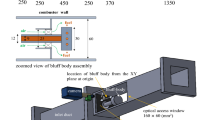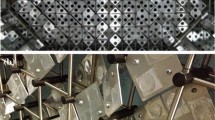Abstract
The influence of geometric and regime parameters of a swirl burner with a central body and a diffuser on flow characteristics and flame stabilization in the combustion of a premixed gas mixture was investigated using Reynolds equations and thek-ε model of turbulence.
Similar content being viewed by others
References
D. M. Khzmalyan, and A. Ya. Kagan,Combustion Theory and Furnace Processes [in Russian], Énergoatomizdat, Moscow (1976).
G. E. Ozhigov, “Some aerodynamic aspects and their role in designing modern swirl burners with low harmful emissions,”Sib. Fiz.-Tekh. Zh., No. 1, 60–67 (1991).
A. K. Gupta, D. G. Lilley, and N. Syred,Swirl Flows, Abacus Press (1984).
V. V. Pomerantsev, K. E. Aref'ev, D. B. Akhmedov, et al.,Fundamentals of the Practical Theory of Combustion [in Russian], Énergoatomizdat, Leningrad (1986).
D. G. Lilley, “Combustion in swirl flows: a review,”AIAA J.,15, No. 8, 1063–1067 (1977).
O. V. Matvienko, and V. A. Arkhipov, “Unsteady combustion in a channel with gas stream swirling and its termination,”Fiz. Goreniya Vzryva,35, No. 4, 33–49 (1999).
D. G. Lilley, D. L. Rhode, and D. K. McLaughlin, “Mean flow fields in axisymmetric combustor geometries with swirl,” AIAA Paper No. 0177, 1–13 (1982).
D. B. Spalding, “Mathematical models of turbulent flames: A review,”Combust. Sci. Technol.,13, No. 1, 3–25 (1976).
Ya. B. Zel'dovich, G. I. Barenblatt, V. B. Librovich, and G. M. Makhviladze,The Mathematical Theory of Combustion and Explosions, Plenum, New York (1985).
C. K. Westbrook and F. L. Dryer, “Chemical kinetics modeling of hydrocarbon combustion,”Prog. Energy Combust. Sci.,10, No. 1, 1–57 (1984).
B. P. Ustimenko, K. B. Dzhakupov, and V. O. Krol',Computational Modeling of Aerodynamics and Combustion of Furnace Technological Devices [in Russian], Nauka, Alma-Ata (1986).
M. T. Abujelala and D. G. Lilley, “Confined swirling flow predictions,” AIAA Paper No. 136 (1983).
S. V. Patankar,Numerical Heat Transfer and Fluid Flow, Hemisphere-McGraw-Hill, Washington-New York (1980).
G. N. Abramovich, T. A. Girshovich, S. Yu. Krasheninnikov, et al.,Theory of Turbulent Jets [in Russian], Nauka, Moscow (1984).
B. Lewis and G. Von Elbe,Combustion, Flames, and Explosions of Gases, Academic Press, New York-London (1961).
Author information
Authors and Affiliations
Additional information
Translated fromFizika Goreniya i Vzryva, Vol. 35, No. 5, pp. 21–26, September–October 1999.
Rights and permissions
About this article
Cite this article
Arkhipov, V.A., Matvienko, O.V. & Rudzei, E.A. Influence of geometric and regime parameters on flame stabilization of a swirl burner. Combust Explos Shock Waves 35, 483–488 (1999). https://doi.org/10.1007/BF02674490
Received:
Revised:
Issue Date:
DOI: https://doi.org/10.1007/BF02674490




